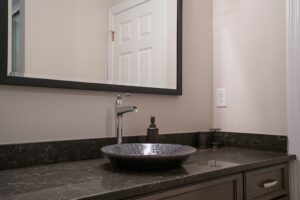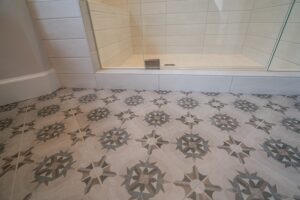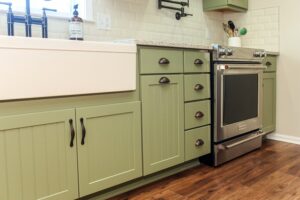Keep Your Countertops, Flooring and Cabinets in Top Shape for 2019 with this Guide
Investing in high quality hard surfaces in your home is worth it, but many materials require special care to maintain and preserve them. Though not very difficult, it is important to use the right cleaning agents and procedures.
Here are some tips for caring for your countertops, flooring and cabinets that will help your investment last for many years to come.
Countertops
Though most countertops are heat resistant and durable, it is best to take preventive measures to preserve surface longevity. Here are important tips for all surfaces:
- Always use coasters for drinks to prevent water stains and always use trivets or pot holders for hot pans to prevent drastic changes in countertop temperature.
- Prevent scratches from knives by using a cutting board.
- When cleaning, it’s best to skip abrasive chemical cleaners, solvents and sponges as this will weaken the sealant, causing the counter to become more susceptible to stains and damage.
- After you’ve cleaned your counter, dry it off with a fresh and dry microfiber cloth to prevent water stains.
 Quartz
Quartz
Regularly clean with a damp cloth using mild dish soap and warm water, or a cleaner made for quartz to prevent staining from everyday use. Dry with a clean microfiber cloth. Quartz requires less maintenance than the other stones due to its non-porous, sealed surface, therefore there is no reason to reseal it.
Granite
It’s important to avoid leaving spills unattended on granite as they can quickly cause stains or discoloration due to the material’s porous nature. Regularly clean using a damp cloth with a mild dish soap and warm water or a cleaner made for granite. Make sure to dry with a clean microfiber cloth.
For stains on granite, clean with a paste of baking soda and water for oil-based stains, or hydrogen peroxide for water-based stains. Apply the paste to the stain, cover with plastic wrap, and tape down the edges. Let the paste sit for a few days or overnight, and then rinse off. Repeat the process if the stain isn’t completely gone. Be sure to do a spot test first to make sure the method won’t affect the color or finish of the stone. Typically, granite is re-sealed once or twice a year for best results.
Butcher Block
Use of bleach or harsh chemicals may cause damage to the color or the finish of wood. To clean, reach for a mild dish soap and damp cloth. You can also use a cleaner specifically for butcher block. If the counter becomes irredeemably stained or unevenly worn, you can always refinish and reseal it.
Additionally, if not oiled regularly, wood will dry and split over time. Oiling butcher block only takes a few minutes, but the oil needs time to penetrate the wood. It’s best to apply oil before bed, so it can sit overnight. To oil, use a soft rag and evenly distribute a generous amount of oil onto the surface of your butcher block. Let it sit for 10 to 15 minutes, and then use the rag to wipe off any excess oil that is still sitting on the surface of the wood. Leave your butcher block undisturbed for several hours or overnight to allow the oil to absorb completely.
What to oil it with? Food-safe mineral oil or a butcher block specific oil/conditioner are both good options. Do not use vegetable oils such as olive or sunflower, because it will eventually go rancid and not be safe for food surfaces.
 Tile
Tile
Porcelain and Ceramic
Vacuum or dust tile floors at least once a week. Using a squeegee in the shower daily to get rid of excess water will help prevent water stains. Tiles can be cleaned with water or a mild soap as well as a cleaner specific to tile.
To prevent mildew or mold growth in the shower, spray with diluted tea tree oil. To clean soap residue out of the shower, use baking soda and water then rinse and dry thoroughly. To clean water spots, clean with water and distilled vinegar.
We recommend not using products containing ammonia, bleach or any type of acid-based cleanser; these can alter the tile color and/or stain the grout. Do not use oil-based detergents, wax cleaners or any cleaners that contain dye or coloring. Avoid steel wool to clean tile-small particles of steel can become embedded in the tile and grout, eventually causing rust stains. The use of bristle or scrub brushes can scratch the tile surface.
Natural Stone (Travertine, Slate, Marble)
Most natural stone should be sealed right after installation, which will provide extra protection. Typically, sealers last for a few years if properly maintained, but like everything else, they eventually break down and should be reapplied periodically.
When cleaning, always use a neutral pH tile or stone cleaning product. Do not use acidic cleaners like lemon juice or vinegar. Also stay away from bleach or other ammonia cleaners. A mild soap and water with a non-abrasive sponge or rag should do the trick.
Like most other surfaces in your home, dust or sweep your natural stones regularly and keep dry to prevent water spots. If you’re concerned about water spots, mildew and dulling of the stone in your shower, be sure to remove excess water on the walls with a squeegee or towel after you shower. Natural stone that is constantly wet gives mildew and mold a chance to grow. Using a squeegee allows the stone to air dry faster, but you can help it along by ensuring your bathroom has proper ventilation.
Flooring
 Wood, Vinyl and Laminate Floors
Wood, Vinyl and Laminate Floors
Keep pet nails trimmed and their paws clean. Pets can track in substances that cause scratching and stains. Use protective window coverings to block UV rays and excessive heat on floors. Most flooring types will gradually age from sun and traffic, so it’s a good idea to rearrange rugs and furniture periodically to help it age evenly. Avoid excessive moisture by wiping up spills when they occur. Invest in floor mats for high traffic areas to prevent excessive wear, and place protective pads under heavy furniture for an extra layer of protection. Lastly, avoid walking on your floors with spiked or damaging shoes.
To clean wood floors, use ice to harden tough substances like wax or chewing gum, and then gently scrape with a plastic scraper or a credit card. Be careful not to scratch the surface and wipe the area clean with a soft, slightly damp cloth. Use a dust mop, soft bristle broom or a vacuum cleaner with suction only to remove dust and dirt on a regular basis. This prevents gritty dirt and particle build-up that can scratch your surfaces.
To clean laminate or vinyl floors, it’s best to find a cleaner meant for that surface as soaps or chemical cleaners can dull or stain the surface. Bona products are great for wood and laminate, and Woca Natural Soap is great for oil-based wood products. Armstrong Once ‘n Done Resilient & Ceramic Floor Cleaner is good for vinyl, LVP, ceramic, marble and stone floors. When using a wood floor cleaner, use a damp (not overly wet) mop and follow directions on the bottle. Dry the floor when done, so no wet spots are left behind.
If your waxed floor dulls, try buffing to restore shine. If buffing does not present results, a wax can be applied. You must use a wax compatible to the finish of your flooring (polyurethane surface finish vs. wax or penetrating stain finish). Avoid wax build-up under furniture and other light traffic areas by applying wax in these spots every other waxing session.
After many years of wear and tear, you might consider having your floors resanded and refinished to restore them. Laminate or vinyl floors cannot be refinished. Engineered floors can be refinished typically one to two times, and solid hardwood floors can be refinished several times.
 Cabinets
Cabinets
Simple regular maintenance is key to keeping up with new cabinets. Most cabinet types, including laminate, painted or stained wood, and MDF cabinets, can be cleaned with dish soap and warm water. This mild solution acts as a degreaser and is enough to remove food smudges, dust and minor grease build-up from your cabinets. Don’t forget the edges, sides and insides of your cabinets.
Rinse thoroughly with another clean cloth before drying with a final cloth. Leaving water on your cabinets can discolor and damage them. If a stronger solution is desired, make sure you test any chemical cleaner in a small hidden spot first to make sure no damage occurs to the finish. Be careful using magic eraser or steel wool to scrub your cabinets as these can take the finish or paint off. Also, avoid cleaners with harsh chemicals, especially those that contain bleach, ammonia or paint-thinning products like nail polish remover.
Extreme heat can damage cabinets as well. This is mostly a concern when using the self-cleaning feature on your oven. To minimize any damage from escaping heat during this process, you can remove doors and drawers nearest the oven before beginning. Sunlight can fade or darken certain cabinet materials as well. To prevent sun bleaching or damage, use blinds or drapes on windows that provide direct light.
When cleaning glass doors, make sure to use ammonia free glass cleaner on a microfiber cloth, and avoid contact with the surrounding cabinets. It’s best not to spray cleaner directly on glass, but to instead spray onto the cloth and then clean.
Simple maintenance and regular cleaning can keep your home’s surfaces in tip-top shape for many years to come. If your home is aging and you’re thinking of updating cabinets, countertops, floors or other surfaces, contact our design/remodeling professionals to see how we can help transform your home this year.
